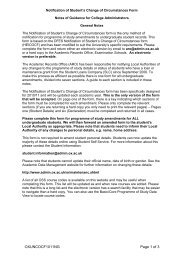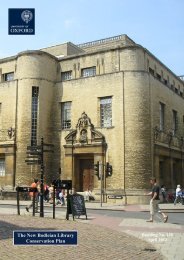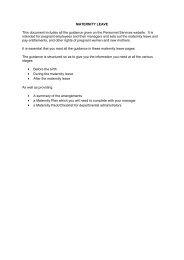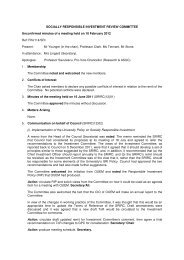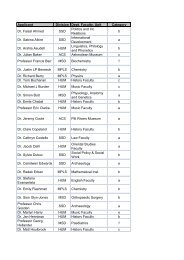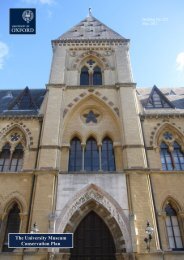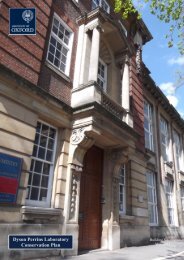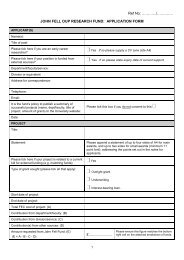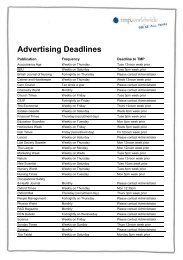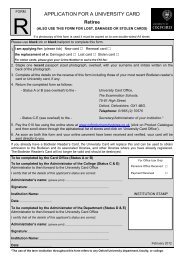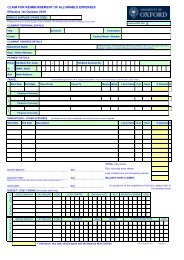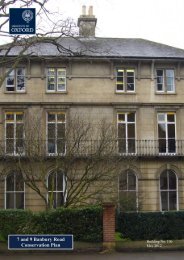Environmental Sustainability Report - University of Oxford
Environmental Sustainability Report - University of Oxford
Environmental Sustainability Report - University of Oxford
Create successful ePaper yourself
Turn your PDF publications into a flip-book with our unique Google optimized e-Paper software.
<strong>University</strong> <strong>of</strong> <strong>Oxford</strong> <strong>Environmental</strong> <strong>Sustainability</strong> <strong>Report</strong> 2010/114Carbon reductionThe <strong>University</strong> increased its absolutebuildings-related emissions by 2.2% (from79,612tCO 2 in 2009/10 to 81,362tCO 2in 2010/11). However, emissions persquare metre floor space fell by 2.9%.The emissions increase was due to theGraph showing how much the <strong>University</strong>needs to reduce its emissions by 2020:Tonnes <strong>of</strong> CO290,00080,00070,00060,00050,00040,00030,00020,00010,00041,28177, 93765,980Actual emissions frombuildings and owned vehiclesBusiness as usual 2020 projectionHEFCE 2020 targetPreferred CarbonManagement Scenario29,500m 2 expansion <strong>of</strong> the <strong>University</strong>estate (Earth Sciences building, SwindonBook Store and <strong>Oxford</strong> MolecularPathology Institute). Total building-relatedenergy costs were £12,040,000.90/9191/9292/9393/9494/9595/9696/9797/9898/9999/0000/0101/0202/0303/0404/0505/0606/0707/0808/0909/1010/1111/1212/1313/1414/1515/1616/1717/1818/1919/2020/21YEAR37,60976,88544,152600500We set carbon reduction targetsIn 2011 the <strong>University</strong> agreed thefollowing carbon reduction targets:reduce carbon emissions by 11% belowthe 2005/6 baseline by 2015/16reduce carbon emissions by 33% belowthe 2005/6 baseline by 2020/21We published a CarbonManagement StrategyBased on current trends, <strong>University</strong>emissions are likely to reach 76,885tCO 2by 2020. To meet our targets, we mustreduce emissions to 58,722tCO 2 by2015/16 and 44,152tCO 2 by 2020/21.The Carbon Management Strategyoutlines how the <strong>University</strong> can meet itstargets by using energy more efficiently,investing in energy saving equipment andenergy efficient buildings.Total (t)We produced our own electricity2,445.8530The Biochemistry building’s solar5971.72photovoltaic installation generated 93.815,700 kWh <strong>of</strong> electricity comparedto 3,500 kWh last year – an increase<strong>of</strong> 63%. FAI Farms – tenants on the<strong>University</strong> owned Wytham Estate –installed photovoltaics on the farm’sro<strong>of</strong>s to generate renewable electricity.We created an onlineEnergy ToolkitThe Energy Toolkit contains top tips forstaff and students on how to use energymore efficiently:www.ox.ac.uk/staff/news/energy_toolkit.htmlIn 2012 the <strong>University</strong> will finalise its carbonreduction plan and continue to reducecarbon as part <strong>of</strong> its 10:10 Campaign.600400
<strong>University</strong> <strong>of</strong> <strong>Oxford</strong> <strong>Environmental</strong> <strong>Sustainability</strong> <strong>Report</strong> 2010/115Water consumption20/211,000s m 3In 2010/11 the <strong>University</strong> consumed349,490m 3 water compared to347,364m 3 in 2009/10 – an increase<strong>of</strong> 0.6%.We set a water reduction targetThe <strong>University</strong> set a water target toreduce water by 11% (38,210m 3 ) by2015 compared to 2009/10 levels(347,364m 3 ). This means the maximumamount <strong>of</strong> water that the <strong>University</strong> can6005004003002001000Total (t)2,445.85305971.7293.81consume in 2015 is 309,154m 3 . Whilethis is a challenging target, the <strong>University</strong>’swater consumption has been slowlydecreasing over the last decade.Graph showing <strong>University</strong> waterconsumption 2001-2011:We published a WaterManagement StrategyThe <strong>University</strong> published a WaterManagement Strategy which providesa road map for reducing waterconsumption in the <strong>University</strong>:www.admin.ox.ac.uk/estates/environment/waterWe installed rainwaterharvesting in our buildingsThe <strong>University</strong> installed rainwaterharvesting systems in four locations,to flush WCs:Biochemistry building has rainwatercapacity <strong>of</strong> 18m 3 and used 176m 3(1.9% <strong>of</strong> total building’s water use)Earth Sciences has rainwater capacity<strong>of</strong> 6m 3 – no water data availableOld Road Cancer Research Building hasrainwater capacity <strong>of</strong> 18m 3 and used366m 3 (2.6% <strong>of</strong> total water used)<strong>Oxford</strong> Molecular Pathology Institutehas rainwater capacity <strong>of</strong> 16m 3 –and used 100m 3 <strong>of</strong> waterHow much did we pay forour water?In 2010/11 the <strong>University</strong>’s total watercosts were £601,173 compared to£592,886 in 2009/10 – an increase <strong>of</strong>1.4%. The <strong>University</strong> pays over £1 per m 3water and a further £0.53 per m 3 to treatwaste water (a cubic metre is equivalentto 2,000 half litre bottles <strong>of</strong> mineralwater). The cost <strong>of</strong> water will continueto rise due to water scarcity, maintenanceand treatment, so we must use watermore efficiently.Case studyThe Clarendon Physics Laboratory cutwater consumption between 2006 and2011 by expanding their process coolingsystem. A water audit showed their waterconsumption reduced 23,600,000 litresper year over a 5 year period (42%).We’ll measure and report our carbon (CO 2 )emissions generated from water consumption,as required by HEFCE. In 2009/10 the<strong>University</strong> generated 367 tonnes <strong>of</strong> ‘indirect’CO 2 from water consumption due to theabstraction, transportation and processing<strong>of</strong> water (water’s carbon footprint is 1.05kgCO 2 per m 3 ).In 2012 the <strong>University</strong> will implement itsWater Management Strategy and reducewater consumption:prioritise water efficiency in buildingsthat use lots <strong>of</strong> waterincrease rainwater recyclingfit low flow taps and showers andWC water saving devicescalibrate taps and showers for shorterrun timesfit smart meters on supplies to identify leaksrationalise the use <strong>of</strong> purified water andincrease the prevention <strong>of</strong> limescale build-up2000/012001/022002/032003/042004/052005/062006/072007/082008/092009/102011/12YEAR
<strong>University</strong> <strong>of</strong> <strong>Oxford</strong> <strong>Environmental</strong> <strong>Sustainability</strong> <strong>Report</strong> 2010/116TravelCarbon emissions frombusiness flightsIn 2010/11 the <strong>University</strong>’s carbonemissions from business air travelincreased by 13% (from 6,100 tCO 2in 2009/10 to 6,981 tCO 2 in 2010/11(accounting for 7% <strong>of</strong> the <strong>University</strong>’stotal carbon emissions).Carbon emissions fromfleet vehiclesIn 2010/11, emissions from the<strong>University</strong>’s fleet vehicles increasedby 3.5% (from 398 tCO 2 in 2009/10,to 412 tCO 2 in 2010/11), due to the<strong>University</strong> increasing its vehicles from111 to 115.Travel targetOur travel target is to reduce the %<strong>of</strong> staff who usually travel to and fromwork by car from 23% to 18% by 2012.We published a BusinessTravel ToolkitTo encourage our staff and studentsto reduce their travel-related carbonemissions we published an online BusinessTravel Toolkit with information on walking,cycling, public transport and car sharingin <strong>Oxford</strong>shire:www.admin.ox.ac.uk/estates/travelWe set up videoconferencingThe <strong>University</strong> set up a fully-servicedvideo and teleconferencing suitefor staff and students at the MediaProductions Unit.“I just want to pass on my sincereand heartfelt thanks to the EstatesDirectorate. I have really appreciatedall the cycle-friendly perks thatthe <strong>University</strong> provides, such as theMobile Mechanic, the Cycle Schemeand cycle safety initiatives.”Research Midwife, National PerinatalEpidemiology UnitIn 2012 the <strong>University</strong> will improveits sustainable travel facilities for staffand students:set up a more efficient mobile cyclerepair schemeimprove cycle and pedestrian facilitiesrun safe cycling workshops for staffand studentsprovide staff training for videoconferencing and web based onlinemeeting servicesconduct a staff and student travel surveyWe set up a JourneyshareschemeThe <strong>University</strong> teamed up withJourneyshare – the largest car sharenetwork in the UK to enable staff tocar share, walk or cycle together in<strong>Oxford</strong>shire, for free.
<strong>University</strong> <strong>of</strong> <strong>Oxford</strong> <strong>Environmental</strong> <strong>Sustainability</strong> <strong>Report</strong> 2010/117Waste, recycling and reuseIn 2010/11 the <strong>University</strong>’s preferredwaste contractors collected a total3,168.38 tonnes <strong>of</strong> non-hazardouswaste. Of this, 1,792.53t went tolandfill and 653.32t was recycled,which included mixed recycling (543.87t);baled cardboard (59.53t); separateglass collections (29.12t) and separatefood waste collections (20.8t). Inaddition to the general recycling, variousunwanted materials were collectedfor reuse or recycling (outlined in thefollowing paragraphs).Pie chart showing total wastecollected in 2010/11Waste to landfill1,792.53tGeneralrecycling653.32tReused (SwapShop) 93.81tTOTAL:3,168.38tConfidentialpaper 30tBuilding &constructionwaste 597tPrintercartridges1.71tPrinter cartridgesand confidential paperIn addition to general waste and recycling,1,834 printer and toner cartridges(1.71t) were recycled through the<strong>University</strong>’s preferred printer cartridgerecyclers (1.398t were reused; 307kgwere recycled and 12kg were landfilled).In addition to general waste and recycling,the <strong>University</strong> recycled 30t <strong>of</strong> itsconfidential shredded paper waste.Building and construction wasteIn addition to general waste and recycling,the John Radcliffe Hospital refurbishment forteaching and administration diverted 597t<strong>of</strong> building and construction waste fromlandfill in 2010/11– recycling plasterboard,timber and metal (100%); cardboard andpaper (98%) and plastic (96%).We published a WasteManagement StrategyThe <strong>University</strong> will implement its recentlypublished Waste Management Strategyfrom 2012 onwards. The strategy aimsto reduce, reuse and recycle unwantedmaterials generated by the <strong>University</strong>and minimise waste to landfill.Virtual Swap ShopIn 2010/11 the <strong>University</strong> reused 93.81t<strong>of</strong> furniture, stationery and laboratoryequipment in-house through its virtualSwap Shop (this saved the <strong>University</strong> anestimated £37,000 from not having tobuy new items).www.admin.ox.ac.uk/estates/environment/ec<strong>of</strong>inanceandswapshopWe set up a virtual Plant SwapDue to the success <strong>of</strong> Swap Shop, we setup a virtual Plant Swap – a give and takescheme for college gardeners, <strong>University</strong>grounds management staff and studentswho are looking for free seeds, plants,garden tools and equipment.We set up free book recyclingThe <strong>University</strong> set up a free bookreuse scheme with Oxfam Bookshop(Oxfam resells the books).We’ll improve our data captureThe <strong>University</strong> will improve its wastedata capture so that it can report onall <strong>of</strong> its waste, recycling and reusemore accurately.We’ll implement the WasteManagement StrategyThe <strong>University</strong> will implement itsWaste Management Strategy acrossthe <strong>University</strong> departments.We’ll expand our reuse schemesThe popularity <strong>of</strong> the <strong>University</strong> SwapShop and Plant Swap shows that thereis lots <strong>of</strong> potential to reuse more itemsin the <strong>University</strong> – we’ll aim to expandon these in 2012.
<strong>University</strong> <strong>of</strong> <strong>Oxford</strong> <strong>Environmental</strong> <strong>Sustainability</strong> <strong>Report</strong> 2010/119Sustainable buildingsWe achieved BREEAM ratings onfour <strong>of</strong> our buildingsThe <strong>University</strong> aims to achieve BREEAMExcellent rating for all new buildings andmajor refurbishments costing more than£1 million. In 2010/11 the <strong>University</strong>completed four building projects thatachieved a BREEAM (Building ResearchEstablishment <strong>Environmental</strong> AssessmentMethod) rating:OMPI – BREEAM ‘Excellent’Swindon Bookstore – BREEAM‘Very Good’Tinsley Building refurbishment –BREEAM ‘Very Good’Rex Richards Doctoral Training Centrerefurbishment – BREEAM ‘Very Good’We installed a ground source heatpump in Earth SciencesThe <strong>University</strong> installed a ground sourceheat pump in the new Earth Sciencesbuilding. A second installation is due in2012 in the Said Business School Phase 2.We installed combined heat andpower (CHP) in the OMPI buildingIn 2011 the <strong>University</strong> installed acombined heat and power (CHP)system in the <strong>Oxford</strong> MolecularPathology Institute (OMPI).We installed rainwaterharvesting systemsSee ‘Water’ section.What is our sustainablebuilding policy?The <strong>University</strong> <strong>of</strong> <strong>Oxford</strong> SustainableBuildings Policy is to ‘build environmentallysustainable buildings and embedsustainable building best practice intothe management <strong>of</strong> the Estate. The<strong>University</strong> will ensure that any newbuilding or refurbishment is planned,built and occupied to ensure the greatestenergy and water efficiency and lowestcarbon emissions that are reasonablein the circumstances. The <strong>University</strong>is committed to making full use <strong>of</strong> itsexisting buildings and wherever possiblewhen expansion is necessary, to thedevelopment <strong>of</strong> sites within walking orcycling distance <strong>of</strong> the remainder <strong>of</strong>the <strong>University</strong>.’We developed a <strong>University</strong>Sustainable Buildings PhilosophyIn 2010/11 the <strong>University</strong> publisheda Sustainable Buildings Philosophy.The philosophy document is a guidefor project managers to ensure ournew buildings and major refurbishmentsmeet the highest environmentalsustainability standards.The <strong>University</strong> will implement theSustainable Buildings Philosophy for allnew buildings and major refurbishmentsand install a ground source heat pump inthe Said Business School Phase 2.
<strong>University</strong> <strong>of</strong> <strong>Oxford</strong> <strong>Environmental</strong> <strong>Sustainability</strong> <strong>Report</strong> 2010/11 10Sustainable purchasingWe reviewed sustainablepurchasing opportunitiesThe <strong>Sustainability</strong> Team and thePurchasing Department workedtogether to identify opportunities forsustainable food, ecologically friendlycleaning products and reducing packagingwaste by including ‘take-back’ schemesin our suppliers’ contracts.The Purchasing Departmentincluded environmental factorsin contract reviewsThe Purchasing Department askedsuppliers to provide information onenvironmental performance andinitiatives to improve sustainabilityand is developing key performanceindicators for inclusion into next year’ssupplier contract review meetings.We increased our electronicpurchase ordersThe Purchasing department worked toensure the 20% <strong>of</strong> suppliers that accountfor 80% <strong>of</strong> purchase orders now receivethem electronically, which saves paper.What’s the <strong>University</strong>’s policyon Sustainable Purchasing?The <strong>University</strong>’s Sustainable PurchasingPolicy was approved by Council in 2008:www.admin.ox.ac.uk/finance/oxonly/purchasing/sustainablepurchasingpolicyIn 2011, the<strong>University</strong> Shopagreed to stock localhoney made by a staffmember – encouraginglocal business andsustainably-sourced food.The <strong>University</strong> will review its SustainablePurchasing Policy which will underpinfuture work.The <strong>University</strong> will report on the indirectcarbon emissions arising from purchasing,in advance <strong>of</strong> HEFCE’s 2013 requirementfor all institutions to measure and reporton the carbon emissions produced throughthe procurement <strong>of</strong> goods and services.We will highlight on our web pages thesuppliers who have the best environmentalsustainability credentials.We consolidated storageThe Purchasing Department reviewedopportunities for consolidating storageat <strong>University</strong> sites and reducing thefrequency <strong>of</strong> deliveries from suppliers.
<strong>University</strong> <strong>of</strong> <strong>Oxford</strong> <strong>Environmental</strong> <strong>Sustainability</strong> <strong>Report</strong> 2010/11 12<strong>Sustainability</strong> in collegesWhile this <strong>Environmental</strong> <strong>Sustainability</strong><strong>Report</strong> doesn’t include data for colleges,which are managed separately from the<strong>University</strong> departments, we think it’s goodto highlight the work they’ve been doingto become more sustainable in 2010/11:Kellogg College set upbee hives in its garden.Other achievements includepromoting Fairtrade products, showingenvironmentally themed films, lecturesand dinners with a Fairtrade focus anda sustainable fashion show (this yearthe college hopes to receive FairtradeFoundation certification). After a surveyrevealed some houses weren’t recycling,the college put in place formal recyclingsystems in Bradmore Road residentialhouses – all <strong>of</strong> which are now recycling.In 2012 the focus will be on optimisingsustainable food consumption andsurveying the college to find out whatpeople prefer to eat (local, organic,seasonal, etc); what the Rewley Houseprocurement procedures are, and workingwith the kitchen to identify areas <strong>of</strong>improvement.Lady Margaret Hall has anallotment, incorporated wildlifehabitat into its garden designand produced a Biodiversity Fact Sheetfor its gardens.Linacre College published acarbon reduction strategy witha target to reduce CO 2 emissionsby 40% by 2020. It installed solar panelswhich generate 15 KWh a day. Thecollege is investing in a rolling programme<strong>of</strong> replacing old windows with highperformancedouble glazing. Students andsupporters have raised funds for a greenscholarship to fund a student to assist thecollege in improving sustainability.Magdalen College grew lots<strong>of</strong> different types <strong>of</strong> herbs in itsgardens for use in its kitchens.Merton College Head Gardenerarranged for a plot <strong>of</strong> college landto be used as an Edible Gardenand supplied leaf mould and compost.The student support committee allocatedtools and a shed. The students organisedgardening sessions and sourced seeds andplants via the <strong>University</strong>’s virtual PlantSwap. The college will install raised bedsin 2012.Rhodes House produceda Biodiversity Fact Sheet forits gardens.Worcester Collegeincorporated wildlife habitatinto its garden design. Theyhave an allotment and apple orchard(the apples are used to make apple juicethat is sold at Waterperry Garden Centrein <strong>Oxford</strong>shire).Queen’s College openedits new auditorium which hasground source heat pumps andhas also gained planning permission toput photovoltaics on its St Aldate’s 90room accommodation building. It hasalso commissioned a sustainability audit.And finally…Several colleges recycled theirold mattresses via a local recycler(they are made into new mattressesand pet bedding).All colleges can now recycleunwanted books for free, via theOxfam bookshop in <strong>Oxford</strong>.Contact the<strong>Sustainability</strong> TeamTo find out more about the<strong>University</strong>’s environmentalsustainability or to give usfeedback on the report, contact:sustainability@oued.ox.ac.uk




